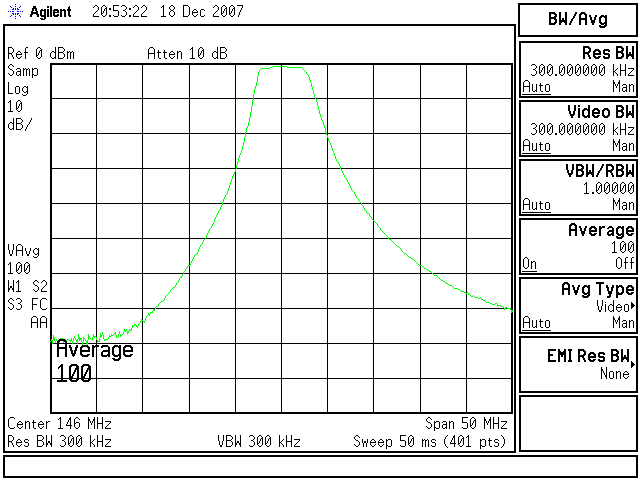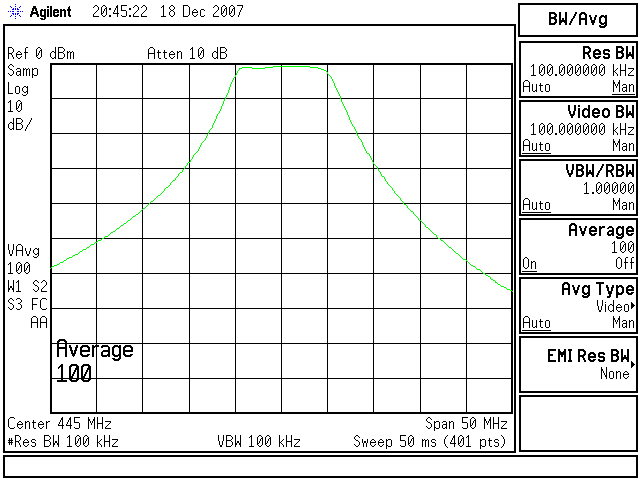Back to Home
VHF and UHF Filters
By Robert W. Meister WA1MIK

|
Up one level Back to Home |
Tests of DCI VHF and UHF Filters By Robert W. Meister WA1MIK |

|
DCI (Digital Communications Inc.) of Canada manufactures all sorts of low-pass, band-pass, and high-pass filters for commercial and amateur use. This article will show the performance of the DCI-146-4H VHF and DCI-445-10C UHF filters.
Product Description:
Each unit contains four poles or sections (that's the smallest configuration DCI makes) and the list price is about $170US. DCI also has filters with six, eight, and ten poles that have significantly sharper out-of-band attenuation and a higher cost. None of the filters I own have mounting holes or tabs; they're designed to sit on top of something else. However, there are rack mounting panels and retrofit mounting kits available. The VHF filters come with UHF-female connectors while the UHF filters come with N-female connectors. The company will make any filter configuration you ask for.
Test Configuration:
An Agilent E4401B 1.5 GHz spectrum analyzer was used to capture the waveforms. RG214 coax cables with crimped-on N-male connectors were used to attach the filters to the analyzer. N-female to UHF-male adapters were used for testing the VHF filter. The cables, connectors, and adapters had 0.27dB loss at 146 MHz and 0.35dB loss at 445 MHz. This loss has been taken into account in the measured data above.
The factory specs shown below were obtained directly from text and graphs in the DCI product brochure PDF files. Bandwidths and frequencies are in MHz. Attenuations are in dB.
| Measurement Parameter |
Factory | Actual | ||
|---|---|---|---|---|
| VHF | UHF | VHF | UHF | |
| Center Frequency | 146 | 445 | 146.3 | 445.0 |
| Total Bandwidth | 4 | 10 | 5.7 | 12.5 |
| Low Frequency | 144 | 440 | 143.5 | 439.0 |
| High Frequency | 148 | 450 | 149.2 | 451.5 |
| Pass-band Loss [1] | 0.42 | 0.29 | 0.30 | 0.20 |
| 3dB Bandwidth | ±2.6 | ±7.2 | ±2.7 | ±5.0 |
| 30dB Bandwidth [2] | ±5.7 | ±16.0 | ±6.0 | ±11.0 |
| 50dB Bandwidth [2] | ±10.2 | ±26.0 | ±10.0 | ±18.0 |
Here's the spectrum analyzer trace showing the full response of the VHF filter. There were other peaks periodically up the band, above 450 MHz.

The spec sheet for this VHF filter can be viewed as a 120kb PDF file here.
Here's the spectrum analyzer trace showing the full response of the UHF filter. There was another peak at approximately 1350 MHz.

The spec sheet for this UHF filter can be viewed as a 110kb PDF file here.
DCI makes 4, 6, 8, and 10 pole filters on both the 150 and 450 MHz bands. For comparison, I checked the graphs of filters tuned to 146 MHz with a 4 MHz bandwidth. Here's the attenuation of a signal at 150 MHz:
4-pole: 20dB; 6-pole: 35dB; 8-pole: 32dB; 10-pole: 72dB.
I also checked the graphs of filters tuned to 445 MHz with a 10 MHz bandwidth. Here's the attenuation of a signal at 455 MHz:
4-pole: 17dB; 6-pole: 38dB; 8-pole: 64dB; 10-pole: 80dB.
All of these graphs are viewable on DCI's web site.
Summary:
These two DCI filters, along with a Comet VHF/UHF duplexer, are in use with a dual-band mobile radio (used as a base station) at my home. I live about 3000 ft from a high-level RF site with dozens of paging, two-way, and trunking system transmitters on it. In particular, there's one paging system on 454.450 MHz, which is exactly 10 MHz above my UHF repeater's output frequency. When I talk on my handheld radios, transmitting on 449.450 MHz, that signal mixes with the paging system's 454.450 signal, and the 5 MHz difference causes all sorts of intermod on 444.450 MHz. Once I added the DCI filter, ALL of the intermod problems went away. Quietness has been retained. As these filters can handle 200 watts of power, they can be used on repeater transmitters, especially those that have built-in circulators which must be followed by filters of some sort.
These products meet or exceed every published specification. This is an unbiased opinion based on actual measurements and experience using the units. They are highly recommended.
A reader reported in May 2011 that DCI has new owners, they wanted $300 to retune a filter that developed high insertion loss, and AES is no longer selling their products.
Ralph Olds originally designed these filters at DCI. He left that company and formed a new company that still makes VHF and UHF filters. He can be reached here at www.ocicom.com.
The author can be contacted at: his-callsign [ at ] comcast [ dot ] net.
Back to the top of the page
Up one level
Back to Home
This page originally posted 18-Dec-07.
Article text, graphics, and hand-coded HTML © Copyright 2007 by
Robert W. Meister WA1MIK.
This web page, this web site, the information presented in and on its pages and in these modifications and conversions is © Copyrighted 1995 and (date of last update) by Kevin Custer W3KKC and multiple originating authors. All Rights Reserved, including that of paper and web publication elsewhere.